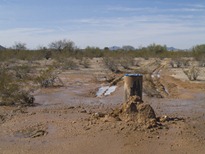"Land Farming" in Texas: Spreading Toxic Drilling Waste On the Land
by Eric Giffrey, FORT WORTH WEEKLY, May 12, 2010
 When Tim and Christine Ruggiero bought their dream home on 10 acres in Decatur six years ago, they imagined their daughter riding horses and taking in the clean country air. The last thing they imagined was that all three of them would end up covered in rashes from being exposed to toxic chemicals such as benzene and arsenic in their own backyard.
When Tim and Christine Ruggiero bought their dream home on 10 acres in Decatur six years ago, they imagined their daughter riding horses and taking in the clean country air. The last thing they imagined was that all three of them would end up covered in rashes from being exposed to toxic chemicals such as benzene and arsenic in their own backyard.
The family doesn’t own the mineral rights on their property, and earlier this year, they had no say in the matter when Aruba Petroleum showed up to drill a gas well 300 yards away from their door. The Ruggieros made a decision then to allow Aruba surface use of part of their land, in return for a $30,000 one-time payment. They didn’t understand then what trouble and toxins they were letting themselves in for.
The drilling caused its own problems, but it wasn’t until the company spread muddy drilling waste over several acres of their land that all three of the Ruggieros, at about the same time, began to suffer from similar-looking rashes.
“We get it in different places on our body,” said Tim Ruggiero. “If you look at it, it all looks like the same rash. One of our neighbors has the same rash, and she has it worse than we do.”
Alisa Rich, president and co-founder of Wolf Eagle Environmental Engineers and Consultants, said that several of her clients have experienced similar rashes that appear as fast as 15 minutes after they are exposed to toxic wastes from gas drilling operations.
“We believe it is from some of the chemicals, specifically some of the sulfites,” she said. The extent of the rash, she said, seems to depend on the concentration of the chemicals.
In the Ruggieros’ case, the foul-smelling mud that drilling crews had spread over their land turned out, when tested by Rich’s company, to contain high levels of arsenic and benzene, both of which can cause cancer.
It’s a situation that is happening more and more often in Texas, as the Barnett Shale boom continues. Drilling produces major quantities of sludgy waste — and many activists, scientists, and landowners are very worried about where that waste is going, what’s in it, and how the dumping of that chemical-laden mud is being regulated.
The practice is called land farming, and it’s legal in Texas and lots of other places, though there are restrictions on where and how much of the drilling waste may be spread and how full of toxins it is allowed to be.
Oil and gas officials say that the process is safe and actually helps the land — that the drilling waste acts as fertilizer and makes grass and other crops grow more lush and green than before.
Ramona Nye, a spokeswoman for the Texas Railroad Commission, which is charged with regulating the oil and gas industry, said that land farms pose no real threat.
Many scientists also say that, if done properly and in small doses, land farming may actually be a viable and safe way to dispose of drilling mud. However, opponents of the practice have documented numerous cases of oil and gas companies cutting corners and risking the safety of the people and animals who live near the land farms and waste pits.
Many rural families fear that anything grown on acreage that has been improperly land farmed may be contaminated with carcinogens and that the grass and crops are potentially harmful to humans and animals. In some cases, they report, animals will not even eat the affected grass. [Read rest of story]


